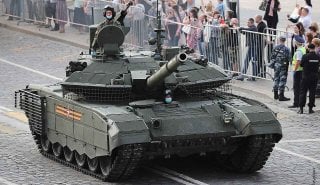More Russian Main Battle Tanks Are Now Headed to the Frontlines
Military analysts have questioned whether the production of new tanks can replace those lost on the battlefield.
Ded Moroz, Russia's version of Father Christmas, generally delivers presents to children on New Year's rather than Christmas – and the Kremlin actually may have received its best gift from Uralvagonzavod. The producer of Russia's T-90M and T-72B3M main battle tanks (MBTs) announced last week that it delivered new batches of the vehicles to start the New Year.
"According to tradition, the tank builders decorated the vehicles from each batch in a New Year's style: a Russian flag was installed on the T-90M Proryv, and a New Year's tree was installed on the 'seventy-two'. Calendars with children's drawings dedicated to the upcoming 90th anniversary of the Uralvagonzavod trade union organization were also included in the tanks," the Russian state-owned conglomerate stated.
The firm further claimed that "production increased from month to month," while last November saw significant output of vehicles."
Upgraded Models
Uralvagonzavod further announced that the latest batch of MBTs have been upgraded based on experiences learned in the ongoing fighting in Ukraine. In total, more than one hundred "changes were made" to the tanks, and each has been outfitted with anti-drone nets, and equipped with "rubber-reinforced protection" – which were previously reported to be mats that cover the gaps between the turret and hulls.
The effectiveness of the mats has been questioned, but both sides have taken desperate measures to add protection from the first-person view (FPV) drones. However, the head of Uralvagonzavod has praised the modifications.
"A tank from early 2022 and a tank from late 2024 are, one might say, two different combat vehicles. For example, if we talk about the protection system, it did not anticipate many of the challenges that we faced literally from the first days of the Second Military Operation," explained General Director of JSC Concern Uralvagonzavod Alexander Potapov. "The corresponding modifications were immediately adopted, the designers worked day and night, and the plant workers promptly made changes to the products that were already being assembled in the workshop. This painstaking and responsible work of the plant workers was recognized by the eighth state award – the Order 'For Labor Valor.'"
Production Fails to Keep Pace With Losses
The Russian-based Uralvagonzavod did not announce how many respective T-72 and T-90s were delivered in the recent batches, but military analysts have questioned whether the production of new tanks can replace those lost on the battlefield.
According to a June 2024 report from the London-based International Institute for Strategic Studies (IISS), 13 batches of T-90Ms had been delivered by that point.
"Reports from the Russian defence sector and think tanks suggest that company-sized batches of between 11–15 tanks are being delivered," IISS explained, putting the number "as high as 267 if all batches included 15 tanks." Obviously, additional batches have been delivered since that report was written, but if we conservatively round up the number to 300 T-90s, it still seems unlikely the production can keep pace with the current rate of attrition.
The Institute for the Study of War (ISW) wrote earlier this month, "Ukrainian forces reportedly destroyed or damaged over 3,000 Russian tanks and almost 9,000 armored vehicles in 2024 as Russia continues to accrue vehicle losses that are likely unsustainable in the medium-term."
ISW added, "Russia's current armored vehicle and tank production rates indicate that such losses will likely be prohibitive over the longer term, particularly as Russia continues to dip into its Soviet-era stocks."
Those stockpiles are being depleted, while the antiquated tanks – notably the T-62s and earlier models – have shown to be ill-suited to the modern battlefield.
Thus, the latest batch of new MBTs should be seen as a much anticipated and appreciated gift to start the New Year, but whether a couple of dozen tanks (if even that many) will make enough of a difference for the Russians in 2025.
Peter Suciu is a Michigan-based writer. He has contributed to more than four dozen magazines, newspapers, and websites with over 3,200 published pieces over a twenty-year career in journalism. He regularly writes about military hardware, firearms history, cybersecurity, politics, and international affairs. Peter is also a Contributing Writer for Forbes and Clearance Jobs. You can follow him on Twitter: @PeterSuciu. You can email the author: [email protected].
Image: Wikimedia Commons.

